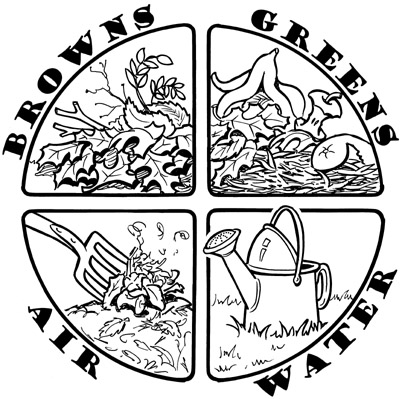Troubleshooting Your Backyard Bin
| Symptoms | Causes | Solutions |
|---|---|---|
| Pile not composting | Too dry | Add water until slightly damp. Turn pile. |
| Too much brown material |
What You Can Compost in Your Backyard Bin
Deciding what to put in your backyard compost bin is an important part of the process. Maintaining the right balance between "brown" and "green" materials will help your compost pile break down faster and keep it from getting smelly. If you are going to compost food scraps you must use a rodent proof bin. For information about what to put in your green bin, check here.
Backyard Composting
 The microorganisms that break down organic material in your soil will happily do the same job in a compost bin. Your role as a composter is to provide the conditions for nature's crew of decomposers—the bacteria, fungi, and bigger creatures such as sow bugs and worms—to go to work. Browns, Greens, Air and Water are the "big four" that will keep every compost pile happy.
The microorganisms that break down organic material in your soil will happily do the same job in a compost bin. Your role as a composter is to provide the conditions for nature's crew of decomposers—the bacteria, fungi, and bigger creatures such as sow bugs and worms—to go to work. Browns, Greens, Air and Water are the "big four" that will keep every compost pile happy.
Related Resources
Learn more about building healthy soil with this guide that provides tips to help you get started in your garden. It covers soil building strategies including composting, sheet mulching and cover cropping.

Albany Civic Center
When the City of Albany renovated the grounds of its Civic Center, they used sheet mulch and compost to naturally improve soil quality, helping create a Bay-Friendly landscape that's healthier for plants and people.
StopWaste at School
StopWaste works with students, teachers, and school district staff across Alameda County to become leaders in waste prevention and proper recycling and composting at school.
Preventing Waste for Residents
StopWaste provides waste prevention information and inspiration for Alameda County residents. We offer free resources to make it easier for you to reduce waste every day and have a greener, healthier home, garden and neighborhood.
If you are an Alameda County resident looking for ways to save money, help the environment and prevent waste, you’ve come to the right place: StopWaste.
In this Preventing Waste section of our website, you’ll find great ideas for reducing waste at home:
Bay-Friendly Scorecard for Civic, Commercial and Multifamily Landscapes V4
ReScape California (formerly the Bay-Friendly Landscaping and Gardening Coalition) manages the Bay-Friendly programs.
Bay-Friendly Landscape Guidelines: Sustainable Practices for the Landscape Professional
This 68-page publication is written for the professional landscape industry. It presents guidance, best practices and resources for the design, construction and maintenance of high performance landscapes.
Using Mulch
The Bay-Friendly Landscape Guidelines recommend protecting all planting areas with a minimum of 3 inches of mulch.
California's Water Efficient Landscape Ordinance (WELO) now requires the use of compost and mulch on permitted landscapes. Find out more.